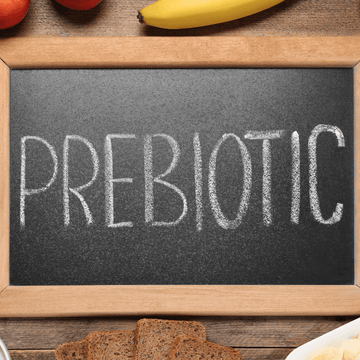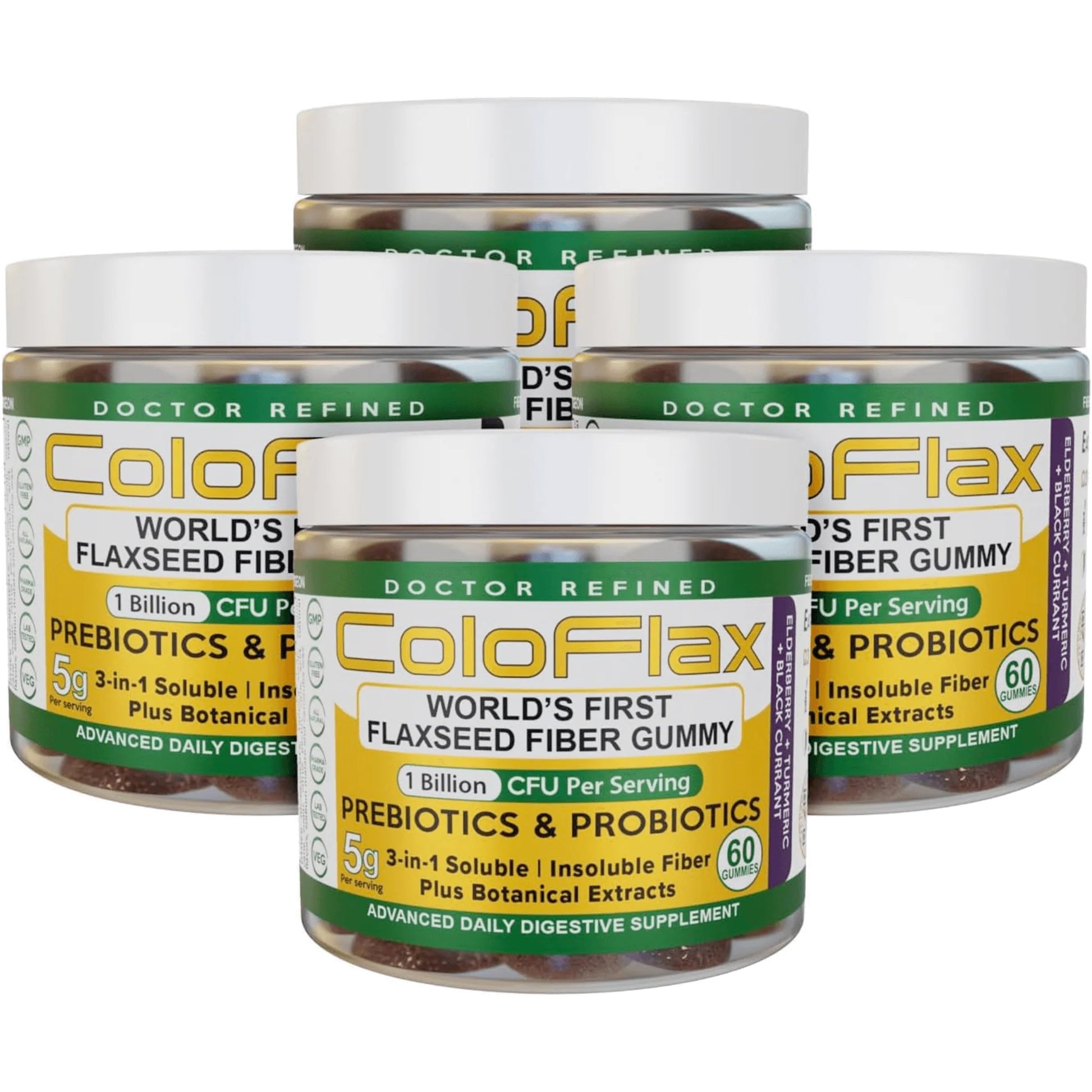Probiotics are the friendly bacteria that live in your gut and contribute to your health and well-being. But these bacteria need food to thrive, and that’s where prebiotics come in.
Prebiotics are a type of dietary fiber that you can find in a variety of foods, the best of which are included below.

Flaxseeds
Flaxseeds are incredible. In fact, it’s not an exaggeration to say that the human race would be decidedly poorer without this plant. Flax gives us the fiber that we convert to linen, the same linen that our ancestors used to create clothing, sails, and even to wrap their dead. The seeds are also highly nutritious, so much so that we made them the primary constituent of our flaxseed fiber gummies.
Consumption of flaxseeds is associated with reduced LDL cholesterol levels and it can also help with constipation and improve overall digestive health. (1)
Flaxseeds contain about two-thirds insoluble fiber and one-third soluble fiber, so you’re getting a mixture of the two and benefiting more as a result. They are also rich in essential fatty acids and compounds known as lignans, which are associated with a variety of health benefits. (2)
We could fill this entire article talking about the nutrient content and health benefits of this potent seed, but we’ve already done that (read more here). Needless to say, everyone can benefit from adding flaxseeds to their diet, and as these seeds are incredibly versatile, it’s very easy to get your fill!

Dandelion Greens
We don’t eat a lot of dandelion greens here in the United States, but they are enjoyed in salads and other side dishes in parts of the Mediterranean. They can be eaten raw or cooked, and while they can be a little tough and somewhat of an acquired taste, they are very good for you.
A single cup of dandelion greens contains around 2 grams of fiber and just 25 calories. They are a good source of vitamins K, A, and C, as well as potassium and calcium. And of course, as they are included on this list, they’re also a great source of prebiotic fiber.
It’s inulin that makes dandelion greens such a potent prebiotic. Not only can it boost your intestinal flora, but studies show that it can help in the treatment of type-2 diabetes. (3)
So, stop throwing those dandelion greens away and start adding them to your salads. Not sure where to start? Try horta, a Greek dish that combines fresh dandelion greens with dill, salt, olive oil, and lemon juice and can be served with crumbled feta and crusty bread.

Chicory Root
Chicory root is a fantastic source of inulin, a prebiotic fiber linked with a variety of health benefits. A regular dose of chicory root could support digestive, liver, immune, and cardiovascular health. If you’re struggling with bouts of constipation, it can also have more of an immediate impact, giving you the fiber you need to have a successful bowel movement and get everything back in working order. (4)
Roasted chicory root is often sold as a coffee substitute, as it has a very similar taste. You can also buy it in supplement form. It’s cheap, widely available, and beneficial.
Incidentally, if you find that chicory root doesn’t quite possess the strong coffee taste that you’re looking for, check out roasted dandelion root. It possesses some of the same health benefits as dandelion greens, but more importantly, it has an incredible coffee-like taste.

Garlic
Garlic is often praised for its cardiovascular benefits, with studies noting that it can help to lower blood pressure and reduce the risk of heart disease. Many of these benefits derive from its high antioxidant content, but garlic also works as a prebiotic fiber by promoting the growth of beneficial gut bacteria. (5)(6)
It’s an incredible foodstuff, and the best thing about it is that it tastes great and works well in a wide variety of dishes. You can add crushed garlic gloves to fried mushrooms, hummus, tzatziki, pasta, stew, and countless other dishes. Of course, if you’re not a fan of its pungent taste then you won’t care much for its versatility either and will want to avoid it at all costs.
In such cases, you can take garlic tablets instead, but when there are so many other prebiotic foods to choose from, there’s no need.

Onions
Onions are used as a base for countless dishes, and for this reason, they’re often dismissed as a vegetable. But they can be just as healthy as every other vegetable you add to that dish, as they are high in prebiotic fiber (inulin) and a type of beneficial carbohydrate known as fructooligosaccharides (FOS).
Furthermore, onions are high in the antioxidant quercetin. It’s thought that natural sources of this compound can support the immune system and help with allergies. In fact, extracts of quercetin are used to create many anti-allergy drugs, and it’s also commonly found in immune-support supplements. (7)

Leeks
Leeks contain inulin, the same prebiotic fiber that makes chicory root so beneficial. It’s low in calories and high in vitamin K, which your body uses to promote blood clotting and keep your bones strong and healthy.
Leeks come from the same family as onions and garlic, so if you’re not keen on the pungent taste of garlic and keep crying over your onions, leeks are a good alternative.

Konjac Root
Extracts of konjac root are used to make low-calorie pasta, noodles, and rice alternatives. These foods are made with small amounts of konjac mixed with water and forming agents. It creates something that has the texture and even the taste of high-carb food but lacks the calorie content.
When eaten, these foods act as a plug. They are digested slowly, thus keeping your stomach full and eliminating cravings.
But don’t dismiss konjac root as just a low-calorie alternative to pasta. It’s very beneficial in its own right.
Konjac root contains glucomannan, which has been shown to help with weight loss in overweight adults. As with other prebiotic fiber and a high-fiber diet in general, konjac can also reduce LDL cholesterol and support cardiovascular health. (8)

Apples
Apples contain a type of fiber known as pectin, which has prebiotic properties. It accounts for most of the fruit’s fiber content and has been shown to help the gut microbiome, potentially assisting with weight loss and general digestive health. (9)
We’ve known about the health benefits of apples for a long time. After all, the saying “An apple a day keeps the doctor away” originated over 150 years ago (in its original form, it was actually “Eat an apple on going to bed and you’ll keep the doctor from earning his bread”). But it’s only in the last few decades that we’ve been able to study the fruit and its constituent components and better understand those benefits. (10)
In addition to their high-fiber content, apples are a source of vitamin C, potassium, vitamin K, and copper, as well as antioxidants that can support digestive and immune health.

Barley
Barley contains beta-glucan, a prebiotic fiber that can support digestive health and may provide other benefits.
Studies on barley-derived beta-glucan have found notable benefits in older participants, with results showing a significant improvement in intestinal flora, which in turn can help with regularity, immune health, and more.(11)
Barley is packed with antioxidants and protein. It has satiating effects and could reduce both blood sugar levels and blood pressure.(12)
It’s a potent grain, and it’s also very easy to find in your local grocery store and even easier to add to meals. You can bake barley into bread or add it to stews and soups, where it acts as a thickener and adds a little more bite.
It can also be made into beer and whiskey, but unfortunately, neither of those will do much for your microbiome!

Burdock Root
In the United Kingdom, they consume a beverage known as dandelion and burdock. In modern times, it’s made using synthetic flavorings. In the middle ages, when this drink was first consumed, it was made using actual fermented dandelion root and burdock root.
It might sound like an odd combination, but it works really well, and those ancient Brits were onto something as these two roots are packed with prebiotic fiber and other nutrients.
We’ve already discussed the benefits of dandelion, but burdock has similar effects. As with onions, burdock root contains FOS, as well as inulin. It is also rich in antioxidants.
Burdock root is not very common these days, but you can still find it as a supplement or use it to fortify foods. In one study, burdock root was made into flour and then added to cookies, with the researchers noting that “Burdock roots may be an effective alternative to provide prebiotic oligosaccharides to bakery products for consumers who search for functional foods with health benefits."

Oats
Oats are a fantastic source of beta-glucan. They are high-fiber, high-protein grains that release energy slowly and help to keep you full for several hours. A regular serving of oatmeal could support digestive and cardiovascular health while helping with a weight loss regime.
Just make sure you don’t add too much sugar or honey to your oatmeal. A little goes a long way, and you can supplement your chosen sweetener with some fruit, such as a banana. Incidentally, bananas are a great fiber source and contain additional nutrients.

Seaweed
Although seaweed is high in prebiotic fiber and nutrients, it’s also high in sodium. Still, if eaten in moderation or used to flavor dishes, both fresh and dried seaweed are highly beneficial.
If we use wakame as an example, 100g contains just 45 calories, yet it also contains a wealth of antioxidants and is a source of iron, phosphorus, magnesium, manganese, potassium, folate, vitamin C, beta carotene, and niacin. Just bear in mind that the same 100g serving has over 870mg of sodium, which is more than a third of your daily recommended intake of this mineral.

Summary: Eat More Prebiotic Foods
For optimal health, include plenty of prebiotic food in your diet. If you’re struggling to meet your DV for dietary fiber or just need a little top-up, check out ColoFlax flaxseed fiber gummies.
These delicious gummies come packed with 5g of fiber, including both soluble and insoluble fiber. They also contain prebiotics, prebiotics, essential fatty acids, and numerous nutrients.
It’s the easiest way to add more fiber to your diet and support your digestive health!
References
- https://pubmed.ncbi.nlm.nih.gov/25829567/
- https://www.ncbi.nlm.nih.gov/pmc/articles/PMC4375225
- https://www.ncbi.nlm.nih.gov/pmc/articles/PMC5553762/
- https://www.sciencedirect.com/science/article/pii/S2225411014000303
- https://www.ncbi.nlm.nih.gov/pmc/articles/PMC7402177
- https://www.sciencedirect.com/science/article/pii/S2213453013000311
- https://www.ncbi.nlm.nih.gov/pmc/articles/PMC6273625/
- https://pubmed.ncbi.nlm.nih.gov/26492494/
- https://pubmed.ncbi.nlm.nih.gov/26938554/
- https://www.ncbi.nlm.nih.gov/pmc/articles/PMC4420713
- https://www.sciencedirect.com/science/article/abs/pii/S0963996910000384
- https://pubmed.ncbi.nlm.nih.gov/31960663/
- https://www.sciencedirect.com/science/article/pii/S0023643817309532






